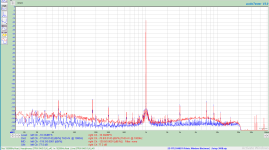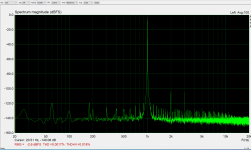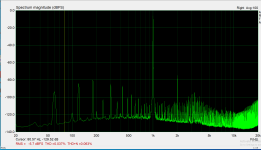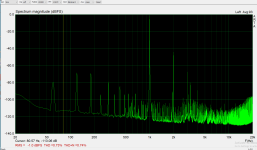OK, new computer in the lab (Garage) and new sound card with lower floor and THD. The old computer was probably 10 to 12 years old and a hodgepodge of parts from my son's discarded gaming system.
Waiting on the local power company to install fiber tomorrow and put everything back in place to start new measurements.
I also have to do comp files for the input offset vs frequency.
Waiting on the local power company to install fiber tomorrow and put everything back in place to start new measurements.
I also have to do comp files for the input offset vs frequency.
Attachments
I still haven't been able to get Audio tester 3d to work happily with the sound card (Asus Strix DLX). ARTA on the other hand seems to be working with the line out (Speaker) drive and Line in. I really liked the display interface for Audio Tester, but it looks like I will have to switch since ARTA works with the line out which has lower THD than the headphone output.
I still have to figure out the cal files to zero the output at 1vrms.
I still have to figure out the cal files to zero the output at 1vrms.
Attachments
Last edited:
The measurements in post #42 you were objecting are just a standard THD measurements of the 300B amplifier. That's what I meant and that's the subject of this thread where low power THD appears to be too high. Are you really interested in the thread?@45 can you explane what you mean with “measurement procedures are quite standard”
Walter use’s a reverse measuring methode with series resistors that are not matching the output impedance of the tube. Special for distortion this is a bad way to measure.
Last edited:
If the measurements where done "standard" then the sowter transformer would measure differently. The Sowter has much better low frequency response.
https://www.sowter.co.uk/specs/sa08.htm
In post 26 we see the measurements of the reverse methode Waltube precented in another topic. If we read radiotron designers handbook we read that distorion is a function of output impedance of the source.
https://www.sowter.co.uk/specs/sa08.htm
In post 26 we see the measurements of the reverse methode Waltube precented in another topic. If we read radiotron designers handbook we read that distorion is a function of output impedance of the source.
I really do not care about how accurate are the measurements in post #26 except that distortion is very low. The point raised was about transformer distortion at 1KHz. Standard method, manufacturer claim, alternative methods they all are in the same ballpark. At 1KHz it is neglectible respect to the amplifier's THD, if the transformer is done properly, even with non-oriented steel core....
I have never used that reverse method but I know that Walter did not invented it. He just uses it as an additional measurement. Distortion is function of the source impendace but it doesn't mean that you cannot reverse the transformer and scale impedances.
In the case of a commerical transformer the best way to spec out a transformer is not using a specific tube plate resistance but using a source impendance EQUAL to the primary impedance. Japanese OPTs are all measured like that. Not only distortion but also frequency response might appear worse (for sure at low freqeuncy), however that way the transformer spefications are valid for more general application. Are they masochist? I think not. That is another reason why you will never find distortion measurements from Japanese manufacturers.
I really cannot see the a reason to be so picky about it as in the end what matters is the distortion of the amplfier and there is a good rule of thumb to know in advance, without any THD measurement, if distortion will be low at low frequency: XL/Req >>1. This condition is only possible with low Zout triodes or higher gain triodes and pentodes using local feedback that result in low source impedance (i.e. less than roughly 1.5-2K, just to put down some numbers). Generally speaking >>1 in practice means equal or better than 8-10. So, if you don't have info or do not trust the manufactuer claim, you can just measure the primary inductance with small signal accurately at 50Hz or less and you will already know what to expect at low frequency in terms of THD. There is really very little additional info you can gain with other measurements regarding the behaviour of the transformer alone at low frequency. It's been done accurately ages ago and doesn;t need to be done every time. Besides, having a good set-up to measure the THD of the whole amplfier or just the output stage (with its actual power supply) is more relevant. That's my opinion of course but now you can see why I do not care about the accuracy of the measurements in post #26. I already knew before post #26.....
I have never used that reverse method but I know that Walter did not invented it. He just uses it as an additional measurement. Distortion is function of the source impendace but it doesn't mean that you cannot reverse the transformer and scale impedances.
In the case of a commerical transformer the best way to spec out a transformer is not using a specific tube plate resistance but using a source impendance EQUAL to the primary impedance. Japanese OPTs are all measured like that. Not only distortion but also frequency response might appear worse (for sure at low freqeuncy), however that way the transformer spefications are valid for more general application. Are they masochist? I think not. That is another reason why you will never find distortion measurements from Japanese manufacturers.
I really cannot see the a reason to be so picky about it as in the end what matters is the distortion of the amplfier and there is a good rule of thumb to know in advance, without any THD measurement, if distortion will be low at low frequency: XL/Req >>1. This condition is only possible with low Zout triodes or higher gain triodes and pentodes using local feedback that result in low source impedance (i.e. less than roughly 1.5-2K, just to put down some numbers). Generally speaking >>1 in practice means equal or better than 8-10. So, if you don't have info or do not trust the manufactuer claim, you can just measure the primary inductance with small signal accurately at 50Hz or less and you will already know what to expect at low frequency in terms of THD. There is really very little additional info you can gain with other measurements regarding the behaviour of the transformer alone at low frequency. It's been done accurately ages ago and doesn;t need to be done every time. Besides, having a good set-up to measure the THD of the whole amplfier or just the output stage (with its actual power supply) is more relevant. That's my opinion of course but now you can see why I do not care about the accuracy of the measurements in post #26. I already knew before post #26.....
In the case of a commerical transformer the best way to spec out a transformer is not using a specific tube plate resistance but using a source impendance EQUAL to the primary impedance
This is the normal way I do the test, then I can move from this point to understand what happen with different values and different levels.
Freq. response and THD/ frequency
Always in backward method.
Of course, at the end the main goal is to check the entire circuit. But In this way I can discriminate the steps.
Just for fun.
Walter
Last edited:
The point, and the japanese are right by not measuring it, they understand the theory behind it. Walter presents a measurement methode and claims that this is the best way to measure it. Horse ****. I can measure a doorbell transformer and show very low thd at 1kHz. If you want thd, measure the whole amplifier (he did not in post 26)I really do not care about how accurate are the measurements in post #26 except that distortion is very low. The point raised was about transformer distortion at 1KHz. Standard method, manufacturer claim, alternative methods they all are in the same ballpark. At 1KHz it is neglectible respect to the amplifier's THD, if the transformer is done properly, even with non-oriented steel core....
I have never used that reverse method but I know that Walter did not invented it. He just uses it as an additional measurement. Distortion is function of the source impendace but it doesn't mean that you cannot reverse the transformer and scale impedances.
In the case of a commerical transformer the best way to spec out a transformer is not using a specific tube plate resistance but using a source impendance EQUAL to the primary impedance. Japanese OPTs are all measured like that. Not only distortion but also frequency response might appear worse (for sure at low freqeuncy), however that way the transformer spefications are valid for more general application. Are they masochist? I think not. That is another reason why you will never find distortion measurements from Japanese manufacturers.
I really cannot see the a reason to be so picky about it as in the end what matters is the distortion of the amplfier and there is a good rule of thumb to know in advance, without any THD measurement, if distortion will be low at low frequency: XL/Req >>1. This condition is only possible with low Zout triodes or higher gain triodes and pentodes using local feedback that result in low source impedance (i.e. less than roughly 1.5-2K, just to put down some numbers). Generally speaking >>1 in practice means equal or better than 8-10. So, if you don't have info or do not trust the manufactuer claim, you can just measure the primary inductance with small signal accurately at 50Hz or less and you will already know what to expect at low frequency in terms of THD. There is really very little additional info you can gain with other measurements regarding the behaviour of the transformer alone at low frequency. It's been done accurately ages ago and doesn;t need to be done every time. Besides, having a good set-up to measure the THD of the whole amplfier or just the output stage (with its actual power supply) is more relevant. That's my opinion of course but now you can see why I do not care about the accuracy of the measurements in post #26. I already knew before post #26.....
I have seen frequency measurements in real circuits of Japanease transformers and most show better low frequency response in real circuits (depending of the Rp of the tube). I also see more ringing problems occasionally and also “better” hf responses. Tango measurements are nice but not really good to todays standerds.
tubes4all,
Please go through all your transformers, and identify all the 'bad' Japanese Interstage and Output Transformers (and other countries of origin too) and ship them to one of us.
We may re-test them. Then, they will probably end up being used in our newest amplifier builds.
Thanks!
Please go through all your transformers, and identify all the 'bad' Japanese Interstage and Output Transformers (and other countries of origin too) and ship them to one of us.
We may re-test them. Then, they will probably end up being used in our newest amplifier builds.
Thanks!
Tango measurements are nice but not really good to todays standerds.
You can find them here
http://www.sacthailand.com/
Really? That's quite an unfair comparison because the Tangos are multipurpose and smaller size. Both U808 and XE20 are used at the 3.5K middle PRIMARY tap, leaving almost 20% of the turns unused. A little bit of (damped) ringing should be expected but they both show at 20 KHz square wave that the others can only dream. They both weight around 2 Kg so there are only 2 possibilities to be usable for a 300B amp: lower efficiency with decent inductance or low inductance with good efficiency. The SAC transformer weights 3.2 KG. Why didn't they compare their transformer to a Tango FC30-3.5S? Because there would be no comparison at all levels. The FC30 has the same high frequency range of the little brothers with no ringing and can count on 26H (more than 2x respect to the XE20). How can this be not really good by todays standards?
@45 I should write it a bit more clear: the measuring methode of Tango is old fashioned and not to todays standards. Tango transformers are really good but specially the top serie.
So what do you thing about publishing frequency response Walter did from the Sowter, i guess you know that that measurement is not true. Or ...?
So what do you thing about publishing frequency response Walter did from the Sowter, i guess you know that that measurement is not true. Or ...?
The method is not old-fashined and has its strenght. If I sell a transformer showing it's suitable fo a range of applications instead of just one I have more potential customers.. Clever, I would say.
What do I think of the measurements? They are fine and can be used for direct comparison with Japanese transformers. So they are useful.
What do I think of the measurements? They are fine and can be used for direct comparison with Japanese transformers. So they are useful.
What do I think of the measurements? They are fine and can be used for direct comparison with Japanese transformers. So they are useful.
My compliments to spent time and words to answer to somemone who can't understand.
Ciao
Walter
Todays standard is ccs, not chokes. But you can dream your own dream.The method is not old-fashined and has its strenght. If I sell a transformer showing it's suitable fo a range of applications instead of just one I have more potential customers.. Clever, I would say.
What do I think of the measurements? They are fine and can be used for direct comparison with Japanese transformers. So they are useful.
The published Sowter frequency response by Walter is fraud but maybe that is also in your world accepted.
I don't need to waste my time with ccs and other stuff of no practical use. I prefer to spend my time in actually building the amplifiers and designing my transformers that just work without wasting time with todays "techniques". Maybe you are the dreamer as I don't think your have ever built an amplifier. Why do I think so? Because otherwise you wouldn't be so picky about things of such limited importance.
For the rest think what you want, I really do not care. Tubes4all you remind me of someone who had exactly your attitude and was banned multiple times.
For the rest think what you want, I really do not care. Tubes4all you remind me of someone who had exactly your attitude and was banned multiple times.
Last edited:
And i get a bad feeling that you are related to Fiat as Walter dos. So you have no good arguments?
So back on topic gentlemen, and ladies if present.
Here are new scans with arta, new computer, new sound card. First is the driver output. Second is the output at 1W at an 8 Ohm resistor. Outputs are scaled through resistor dividers in an attempt to get 1Vrms at the sound-card input. The output tube is the Electro Harmonix that went wonky on me previously.
At one time (1975) I drove a Fiat 1100D in Sigonela Sicily.
Here are new scans with arta, new computer, new sound card. First is the driver output. Second is the output at 1W at an 8 Ohm resistor. Outputs are scaled through resistor dividers in an attempt to get 1Vrms at the sound-card input. The output tube is the Electro Harmonix that went wonky on me previously.
At one time (1975) I drove a Fiat 1100D in Sigonela Sicily.
Attachments
- Home
- Amplifiers
- Tubes / Valves
- 300B with high harmonic distortion



